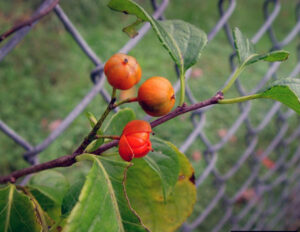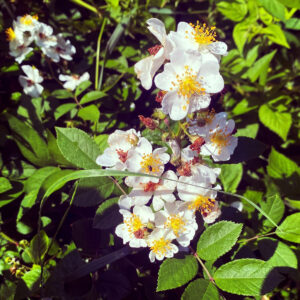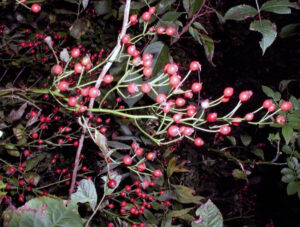
The berries of round leaf bittersweet (Celastrus orbiculatus) grow in clusters at each leaf axil and are beautiful, but this highly invasive plant makes it unsuitable for use in your fall decorations. / Photo Credit: Chris Evans, University of Illinois, Bugwood.org
By Wisconsin DNR
With the holiday season drawing near, it’s time for the Wisconsin Department of Natural Resources (DNR) to remind home crafters to be wary of using invasive plants in fall and winter decorations.
While holiday decorations made from natural materials can be beautiful, some wreaths and other home decorations may contain invasive species.
A quick Google or Pinterest search for décor ideas brings up a slew of orange-tinged images: pumpkins, leaves, pinecones and pretty fall foliage — sometimes boasting small, red-orange berries. While you can safely cloak your home in most of these items, avoid the one with the red-orange berries, as it likely comes from the non-native, woody vine called round leaf bittersweet (Celastrus orbiculatus, previously known as Oriental bittersweet).

American bittersweet (Celastrus scandens), a native plant, has similar berries clustered at the end of each branch and is a great alternative to use in fall wreaths and arrangements. / Photo Credit: Chris Evans, University of Illinois, Bugwood.org
This plant has been used in holiday decorations for years because its beautiful fruiting branches are appealing to wreath makers and centerpiece arrangers. The brightly colored berries are equally appealing to birds, who eat the berries and spread the seeds to new locations — yes, exactly how you think they would.
A rapidly spreading, perennial climbing vine, round leaf bittersweet forms dense stands and shades out other vegetation. It is often found invading forests and may damage trees by girdling trunks with its woody stem or weighing down their crowns, making them susceptible to wind or snowfall damage.
Round leaf bittersweet is regulated under NR40, the Wisconsin rule that makes it illegal to transport or transfer all invasive species. So, you shouldn’t use this plant to make wreaths for others as gifts or for sale.

A holiday wreath featuring holly and invasive teasel. / Photo Credit: Wisconsin DNR
American bittersweet (Celastrus scandens) is a native plant with similar-looking berries that is a great alternative to the aggressive invader, round leaf bittersweet. To tell the two apart, look closely at where the berries are growing on the branches of the plant. American bittersweet will have fewer but larger clusters of fruit (the eye-catching red berries) at the ends of its branches. On invasive round leaf bittersweet, the berries are found clustered at each leaf axil (the angle between the upper side of a stem and a leaf or branch), so they will appear to run all along the branches rather than just at the ends.
You can find more information on how to control round leaf bittersweet in the University of Wisconsin-Madison Extension fact sheet on bittersweet.

A cluster of flowers from the invasive plant multiflora rose. It is recommended that multiflora rose be avoided when making or purchasing holiday decorations. / Photo Credit: Bugwood.org
Other invasive plants are often used in holiday decorations, including wreaths. Some of these species are multiflora rose, nonnative phragmites, cut-leaved teasel and common teasel. These plants are regulated under NR40 because once they find a foothold in the wild, they harm the environment by outcompeting and crowding out native plants, disrupting ecosystem functions for plant life and wildlife. Even a few loose seeds from these decorations can sprout in the spring to take over gardens, roadsides and other natural areas.
Whether you are making items yourself or buying them from a store, it’s important to know what’s in your holiday decorations. Remember that anything containing invasive plants should not be composted or simply left at the curb, because this can result in further spread and infestation of the plant. Securely bag any invasive plants and send them to the landfill.

A close-up photo of the twig of an invasive multiflora rose plant showing rose hips. / Photo Credit: Bugwood.org
In search of some solid wreath-making tips? Look no further:
- The winter edition of Wisconsin Natural Resources magazine, coming in December, will include an article full of wreath-making information, from beginners’ instruction to pro tips — including a reminder about avoiding invasive species.
- A series of winter wreath-making workshops will be held in December at the Kettle Moraine State Forest Northern Unit’s Zillmer Shelter, W833 County Road SS, Campbellsport.

A close-up of the flowering portion of the invasive cut-leaved teasel plant. It is recommended that teasel be avoided when making or purchasing holiday decorations. / Photo Credit: Chris Evans, Bugwood.org
